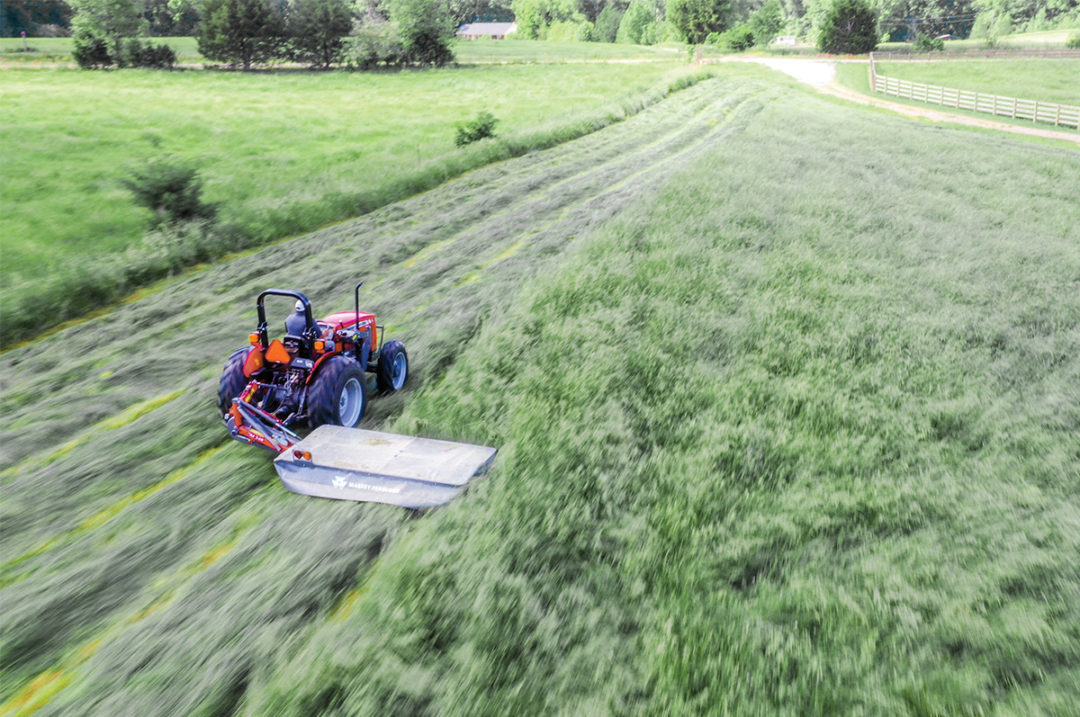Bottom line, investing in the right equipment for a hay operation is a complex calculation. Hay production is a fast, furious and demanding operation. Producers can’t afford downtime. In addition to tools that provide efficiency, durability and a high-quality product, they should also keep return on investment (ROI) and total cost of ownership in mind as part of the initial investment considerations. Here are some helpful tips to get the most out of hay equipment purchases – both now and in the future.
Mowers and conditioners
Acres and time are a primary consideration when it comes to selecting the right mower. Larger hay operations looking to maximize acres will want to consider a self-propelled windrower. These machines offer significant time savings over more traditional mowers. For most operations, though, a disc mower conditioner provides a comfortable balance between productivity and investment costs. A triple mower might be able to match the productivity of a windrower in certain conditions without another engine to maintain.
Disc mowers and disc mower conditioners work with tractors, so it’s important to ensure proper pairing before purchase. From there, producers can look for certain specifications to fit their unique operation. For example, those looking to improve drying times might consider a disc mower or mower conditioner. This feature crimps or crushes forage at specific intervals for faster drydown. Single conditioners offer a 3- to 4-inch crimp. Double conditioners are also available from Hesston by Massey Ferguson that crimp every 1.5 to 2 inches and can shave up to six hours off dry time in certain conditions.
As with any equipment investment, there are some basic principles to consider for maximizing ROI.
- Look for straightforward equipment that is easy to operate and requires minimal maintenance.
- Dependable, rugged design is important, so look for high-quality components and proven reliability.
- Working with a reputable, long-standing brand might have a higher upfront cost, but it ensures parts and service availability for the life of the equipment.

Wheel, parallel bar and other similar rake types are lightweight and can be configured to minimize passes. Photo courtesy of Massey Ferguson.
Rakes
When it comes to selecting the right rake for a hay operation, producers should look for a model that minimizes passes and maximizes quality. Most North American producers use ground-driven rakes. Wheel, parallel bar and other similar rake types are lightweight and can be configured to minimize passes. However, the ground-driven nature of these rakes means higher ash content in baled forage. These models are also prone to roping, which can delay drydown.
Rotary rakes, on the other hand, come with a higher initial investment, but also have the potential for better ROI thanks to higher-quality hay results. Rotary rakes are power takeoff (PTO) driven rather than ground driven, resulting in less external ash content. They also produce fluffy, uniform windrows for more efficient drydown and easier baling.
Once the right type of rake is determined, producers should work with their dealer or equipment manufacturer to ensure a straightforward, dependable operation over the life of the implement.

Operation size and end goal will determine if a round or square baler is ideal for a particular situation. Photo courtesy of Massey Ferguson.
Balers
Operation size and end goal will determine if a round or square baler is ideal for a particular situation. Whichever type the producer chooses, there are certain characteristics that will provide better efficiency and ROI.
First and foremost, look for balers with a streamlined design and fewer moving parts. This cuts down on routine maintenance, wear, part costs and, potentially, downtime. Automatic lubrication systems, chain drives, camless pickup and other high-quality, low-maintenance components will quickly add up to better productivity and profitability.
Ease of use is another important factor to consider. For example, a baler with capacity for a day’s worth of net or twine will minimize downtime. Add an easy load system (ELS) to minimize lifting and handling of rolls for an even better baling experience. Manufacturers are also incorporating serial controls and communications data networks (ISOBUS) and tractor implement management (TIM) compatibility, which allows for less operator input. In normal TIM functions, the baler instructs the tractor to start and stop forward motion and can provide other features depending on the baler configuration.
Make informed decisions for maximum returns
Whether it’s 100 bales or 10,000 bales, matching equipment specifications to production outcomes will provide the best total cost of ownership. Working with local dealers who understand regional challenges will ensure better productivity and profitability.













